Comprehensive Report on Information/Knowledge Management Systems
VerifiedAdded on 2020/10/22
|15
|4922
|180
Report
AI Summary
This report examines information and knowledge management systems, covering various aspects from stakeholder requirements to system analysis. It begins by emphasizing the importance of researching stakeholder needs for effective information management, followed by suggested strategies for addressing issues like data loss, customer complaints, and report generation. The report then delves into the components of information and knowledge management systems, including SWOT analyses and the types of practices, procedures, and processes followed in the workplace. Objectives of information and knowledge management are discussed, along with how these objectives can be achieved and the measures used for recording and monitoring information. The implications and advantages of knowledge management systems, including the importance of review and evaluation, are also explored. Furthermore, the report identifies stakeholder training requirements and how suppliers and contractors can utilize this knowledge. It also addresses knowledge deficiencies in staff and the relevance of legal legislation. The report concludes with an assessment of the system's effectiveness, identifying potential improvements, and suggesting the involvement of other employees in the process. It also includes an email, memo, poster, or webpage to promote the use of the knowledge management system, performance measures, and a summary of the Australian Standard for knowledge management. The report aims to provide a comprehensive overview of the subject, demonstrating skills and knowledge in managing information and knowledge systems.
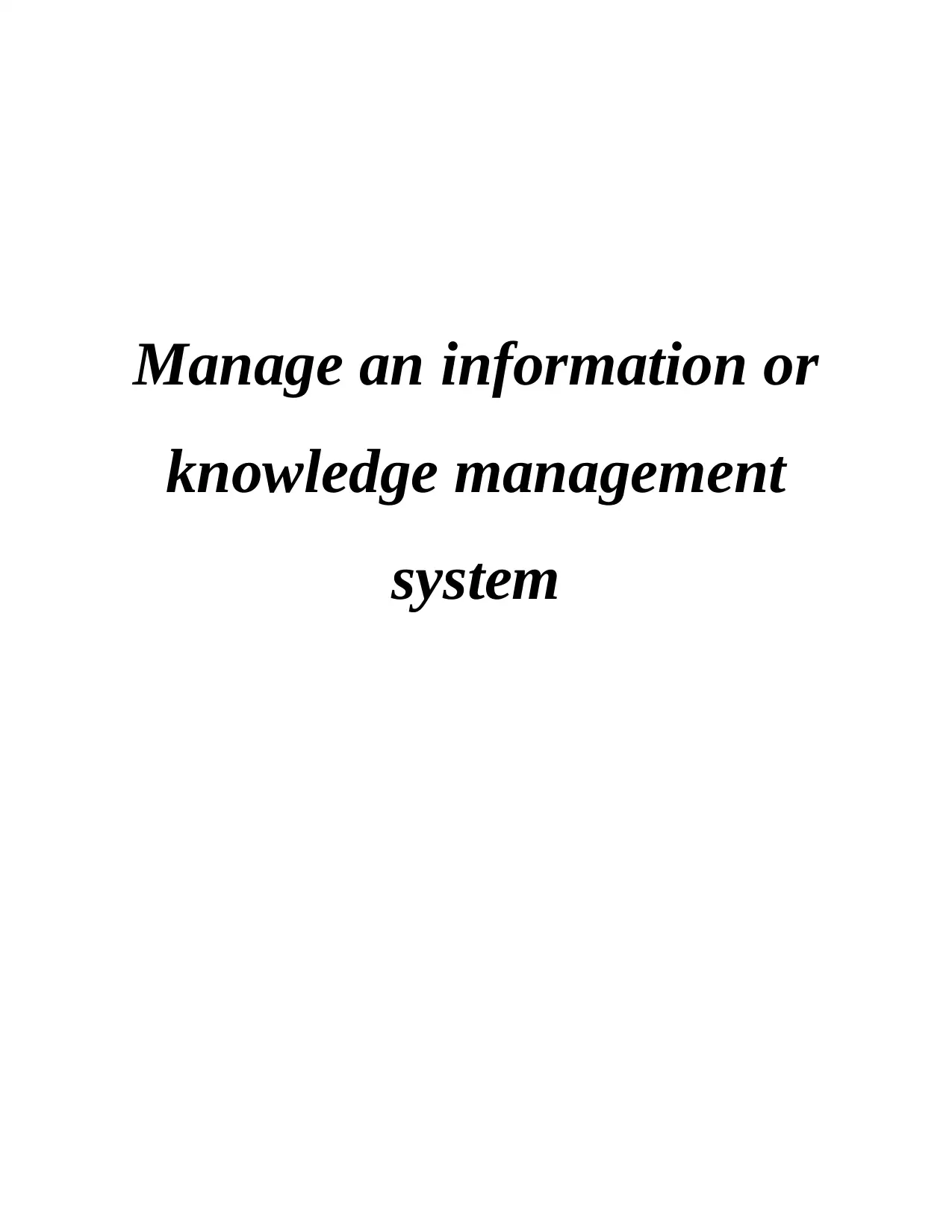
Manage an information or
knowledge management
system
knowledge management
system
Paraphrase This Document
Need a fresh take? Get an instant paraphrase of this document with our AI Paraphraser
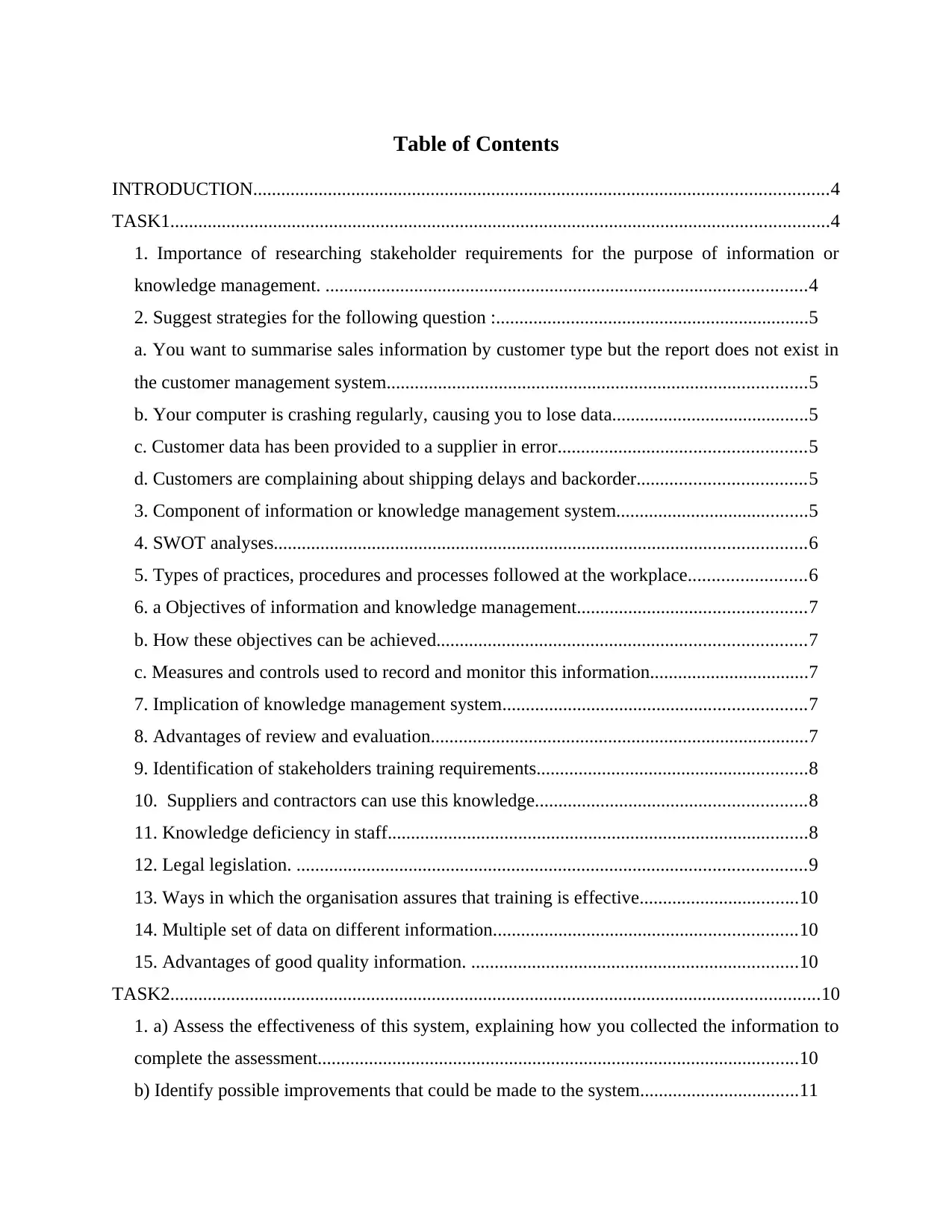
Table of Contents
INTRODUCTION...........................................................................................................................4
TASK1.............................................................................................................................................4
1. Importance of researching stakeholder requirements for the purpose of information or
knowledge management. .......................................................................................................4
2. Suggest strategies for the following question :...................................................................5
a. You want to summarise sales information by customer type but the report does not exist in
the customer management system..........................................................................................5
b. Your computer is crashing regularly, causing you to lose data..........................................5
c. Customer data has been provided to a supplier in error.....................................................5
d. Customers are complaining about shipping delays and backorder....................................5
3. Component of information or knowledge management system.........................................5
4. SWOT analyses..................................................................................................................6
5. Types of practices, procedures and processes followed at the workplace.........................6
6. a Objectives of information and knowledge management.................................................7
b. How these objectives can be achieved...............................................................................7
c. Measures and controls used to record and monitor this information..................................7
7. Implication of knowledge management system.................................................................7
8. Advantages of review and evaluation.................................................................................7
9. Identification of stakeholders training requirements..........................................................8
10. Suppliers and contractors can use this knowledge..........................................................8
11. Knowledge deficiency in staff..........................................................................................8
12. Legal legislation. .............................................................................................................9
13. Ways in which the organisation assures that training is effective..................................10
14. Multiple set of data on different information.................................................................10
15. Advantages of good quality information. ......................................................................10
TASK2...........................................................................................................................................10
1. a) Assess the effectiveness of this system, explaining how you collected the information to
complete the assessment.......................................................................................................10
b) Identify possible improvements that could be made to the system..................................11
INTRODUCTION...........................................................................................................................4
TASK1.............................................................................................................................................4
1. Importance of researching stakeholder requirements for the purpose of information or
knowledge management. .......................................................................................................4
2. Suggest strategies for the following question :...................................................................5
a. You want to summarise sales information by customer type but the report does not exist in
the customer management system..........................................................................................5
b. Your computer is crashing regularly, causing you to lose data..........................................5
c. Customer data has been provided to a supplier in error.....................................................5
d. Customers are complaining about shipping delays and backorder....................................5
3. Component of information or knowledge management system.........................................5
4. SWOT analyses..................................................................................................................6
5. Types of practices, procedures and processes followed at the workplace.........................6
6. a Objectives of information and knowledge management.................................................7
b. How these objectives can be achieved...............................................................................7
c. Measures and controls used to record and monitor this information..................................7
7. Implication of knowledge management system.................................................................7
8. Advantages of review and evaluation.................................................................................7
9. Identification of stakeholders training requirements..........................................................8
10. Suppliers and contractors can use this knowledge..........................................................8
11. Knowledge deficiency in staff..........................................................................................8
12. Legal legislation. .............................................................................................................9
13. Ways in which the organisation assures that training is effective..................................10
14. Multiple set of data on different information.................................................................10
15. Advantages of good quality information. ......................................................................10
TASK2...........................................................................................................................................10
1. a) Assess the effectiveness of this system, explaining how you collected the information to
complete the assessment.......................................................................................................10
b) Identify possible improvements that could be made to the system..................................11
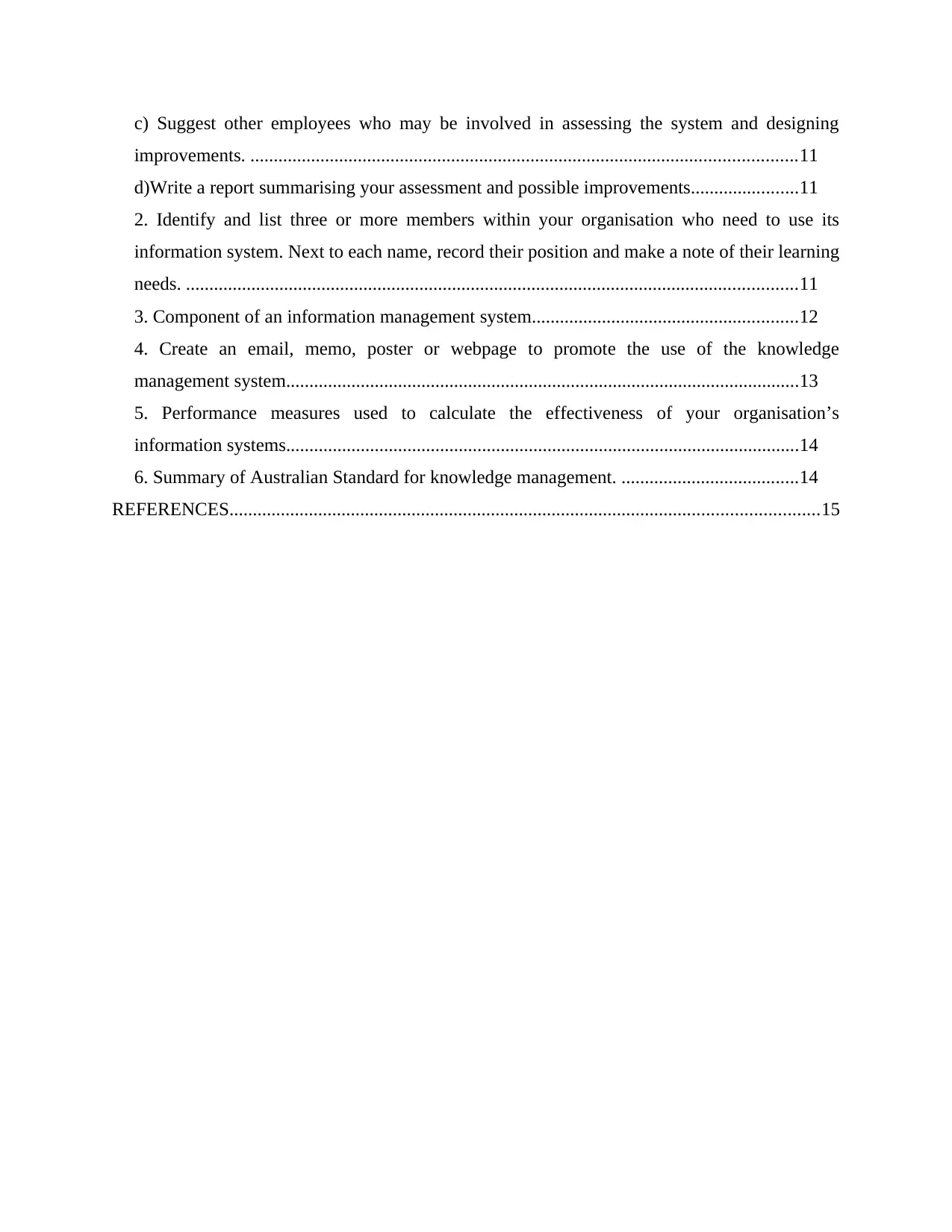
c) Suggest other employees who may be involved in assessing the system and designing
improvements. .....................................................................................................................11
d)Write a report summarising your assessment and possible improvements.......................11
2. Identify and list three or more members within your organisation who need to use its
information system. Next to each name, record their position and make a note of their learning
needs. ...................................................................................................................................11
3. Component of an information management system.........................................................12
4. Create an email, memo, poster or webpage to promote the use of the knowledge
management system..............................................................................................................13
5. Performance measures used to calculate the effectiveness of your organisation’s
information systems..............................................................................................................14
6. Summary of Australian Standard for knowledge management. ......................................14
REFERENCES..............................................................................................................................15
improvements. .....................................................................................................................11
d)Write a report summarising your assessment and possible improvements.......................11
2. Identify and list three or more members within your organisation who need to use its
information system. Next to each name, record their position and make a note of their learning
needs. ...................................................................................................................................11
3. Component of an information management system.........................................................12
4. Create an email, memo, poster or webpage to promote the use of the knowledge
management system..............................................................................................................13
5. Performance measures used to calculate the effectiveness of your organisation’s
information systems..............................................................................................................14
6. Summary of Australian Standard for knowledge management. ......................................14
REFERENCES..............................................................................................................................15
⊘ This is a preview!⊘
Do you want full access?
Subscribe today to unlock all pages.

Trusted by 1+ million students worldwide
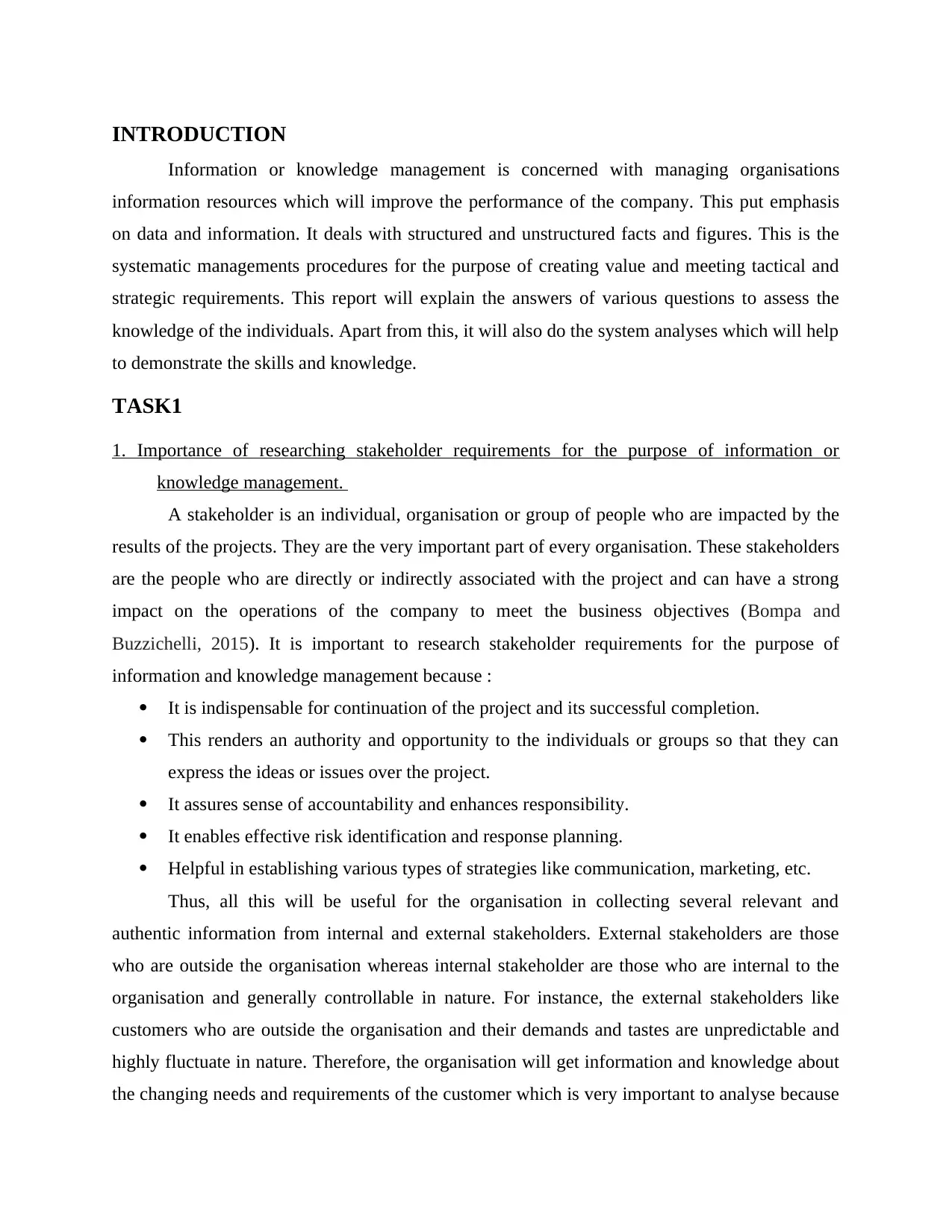
INTRODUCTION
Information or knowledge management is concerned with managing organisations
information resources which will improve the performance of the company. This put emphasis
on data and information. It deals with structured and unstructured facts and figures. This is the
systematic managements procedures for the purpose of creating value and meeting tactical and
strategic requirements. This report will explain the answers of various questions to assess the
knowledge of the individuals. Apart from this, it will also do the system analyses which will help
to demonstrate the skills and knowledge.
TASK1
1. Importance of researching stakeholder requirements for the purpose of information or
knowledge management.
A stakeholder is an individual, organisation or group of people who are impacted by the
results of the projects. They are the very important part of every organisation. These stakeholders
are the people who are directly or indirectly associated with the project and can have a strong
impact on the operations of the company to meet the business objectives (Bompa and
Buzzichelli, 2015). It is important to research stakeholder requirements for the purpose of
information and knowledge management because :
It is indispensable for continuation of the project and its successful completion.
This renders an authority and opportunity to the individuals or groups so that they can
express the ideas or issues over the project.
It assures sense of accountability and enhances responsibility.
It enables effective risk identification and response planning.
Helpful in establishing various types of strategies like communication, marketing, etc.
Thus, all this will be useful for the organisation in collecting several relevant and
authentic information from internal and external stakeholders. External stakeholders are those
who are outside the organisation whereas internal stakeholder are those who are internal to the
organisation and generally controllable in nature. For instance, the external stakeholders like
customers who are outside the organisation and their demands and tastes are unpredictable and
highly fluctuate in nature. Therefore, the organisation will get information and knowledge about
the changing needs and requirements of the customer which is very important to analyse because
Information or knowledge management is concerned with managing organisations
information resources which will improve the performance of the company. This put emphasis
on data and information. It deals with structured and unstructured facts and figures. This is the
systematic managements procedures for the purpose of creating value and meeting tactical and
strategic requirements. This report will explain the answers of various questions to assess the
knowledge of the individuals. Apart from this, it will also do the system analyses which will help
to demonstrate the skills and knowledge.
TASK1
1. Importance of researching stakeholder requirements for the purpose of information or
knowledge management.
A stakeholder is an individual, organisation or group of people who are impacted by the
results of the projects. They are the very important part of every organisation. These stakeholders
are the people who are directly or indirectly associated with the project and can have a strong
impact on the operations of the company to meet the business objectives (Bompa and
Buzzichelli, 2015). It is important to research stakeholder requirements for the purpose of
information and knowledge management because :
It is indispensable for continuation of the project and its successful completion.
This renders an authority and opportunity to the individuals or groups so that they can
express the ideas or issues over the project.
It assures sense of accountability and enhances responsibility.
It enables effective risk identification and response planning.
Helpful in establishing various types of strategies like communication, marketing, etc.
Thus, all this will be useful for the organisation in collecting several relevant and
authentic information from internal and external stakeholders. External stakeholders are those
who are outside the organisation whereas internal stakeholder are those who are internal to the
organisation and generally controllable in nature. For instance, the external stakeholders like
customers who are outside the organisation and their demands and tastes are unpredictable and
highly fluctuate in nature. Therefore, the organisation will get information and knowledge about
the changing needs and requirements of the customer which is very important to analyse because
Paraphrase This Document
Need a fresh take? Get an instant paraphrase of this document with our AI Paraphraser
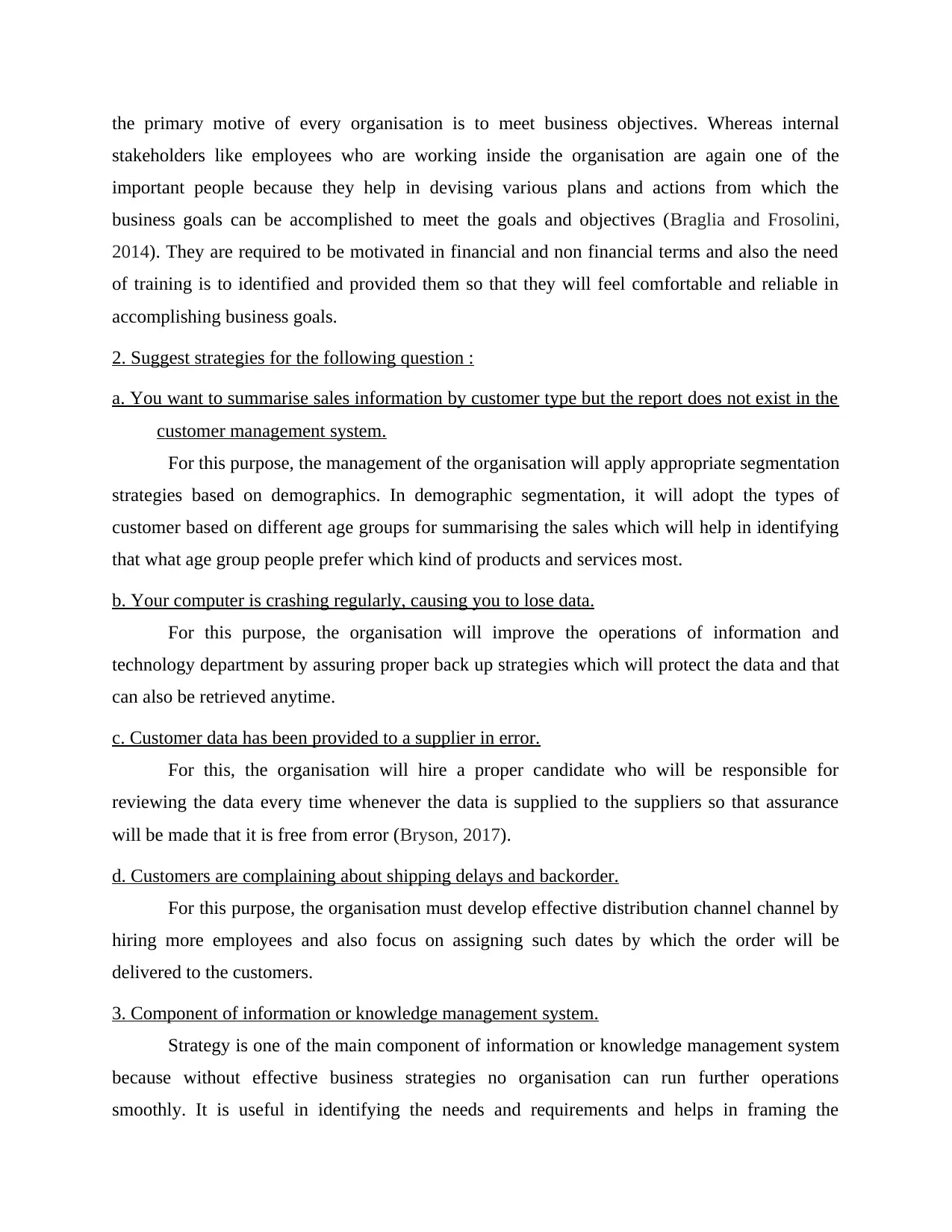
the primary motive of every organisation is to meet business objectives. Whereas internal
stakeholders like employees who are working inside the organisation are again one of the
important people because they help in devising various plans and actions from which the
business goals can be accomplished to meet the goals and objectives (Braglia and Frosolini,
2014). They are required to be motivated in financial and non financial terms and also the need
of training is to identified and provided them so that they will feel comfortable and reliable in
accomplishing business goals.
2. Suggest strategies for the following question :
a. You want to summarise sales information by customer type but the report does not exist in the
customer management system.
For this purpose, the management of the organisation will apply appropriate segmentation
strategies based on demographics. In demographic segmentation, it will adopt the types of
customer based on different age groups for summarising the sales which will help in identifying
that what age group people prefer which kind of products and services most.
b. Your computer is crashing regularly, causing you to lose data.
For this purpose, the organisation will improve the operations of information and
technology department by assuring proper back up strategies which will protect the data and that
can also be retrieved anytime.
c. Customer data has been provided to a supplier in error.
For this, the organisation will hire a proper candidate who will be responsible for
reviewing the data every time whenever the data is supplied to the suppliers so that assurance
will be made that it is free from error (Bryson, 2017).
d. Customers are complaining about shipping delays and backorder.
For this purpose, the organisation must develop effective distribution channel channel by
hiring more employees and also focus on assigning such dates by which the order will be
delivered to the customers.
3. Component of information or knowledge management system.
Strategy is one of the main component of information or knowledge management system
because without effective business strategies no organisation can run further operations
smoothly. It is useful in identifying the needs and requirements and helps in framing the
stakeholders like employees who are working inside the organisation are again one of the
important people because they help in devising various plans and actions from which the
business goals can be accomplished to meet the goals and objectives (Braglia and Frosolini,
2014). They are required to be motivated in financial and non financial terms and also the need
of training is to identified and provided them so that they will feel comfortable and reliable in
accomplishing business goals.
2. Suggest strategies for the following question :
a. You want to summarise sales information by customer type but the report does not exist in the
customer management system.
For this purpose, the management of the organisation will apply appropriate segmentation
strategies based on demographics. In demographic segmentation, it will adopt the types of
customer based on different age groups for summarising the sales which will help in identifying
that what age group people prefer which kind of products and services most.
b. Your computer is crashing regularly, causing you to lose data.
For this purpose, the organisation will improve the operations of information and
technology department by assuring proper back up strategies which will protect the data and that
can also be retrieved anytime.
c. Customer data has been provided to a supplier in error.
For this, the organisation will hire a proper candidate who will be responsible for
reviewing the data every time whenever the data is supplied to the suppliers so that assurance
will be made that it is free from error (Bryson, 2017).
d. Customers are complaining about shipping delays and backorder.
For this purpose, the organisation must develop effective distribution channel channel by
hiring more employees and also focus on assigning such dates by which the order will be
delivered to the customers.
3. Component of information or knowledge management system.
Strategy is one of the main component of information or knowledge management system
because without effective business strategies no organisation can run further operations
smoothly. It is useful in identifying the needs and requirements and helps in framing the
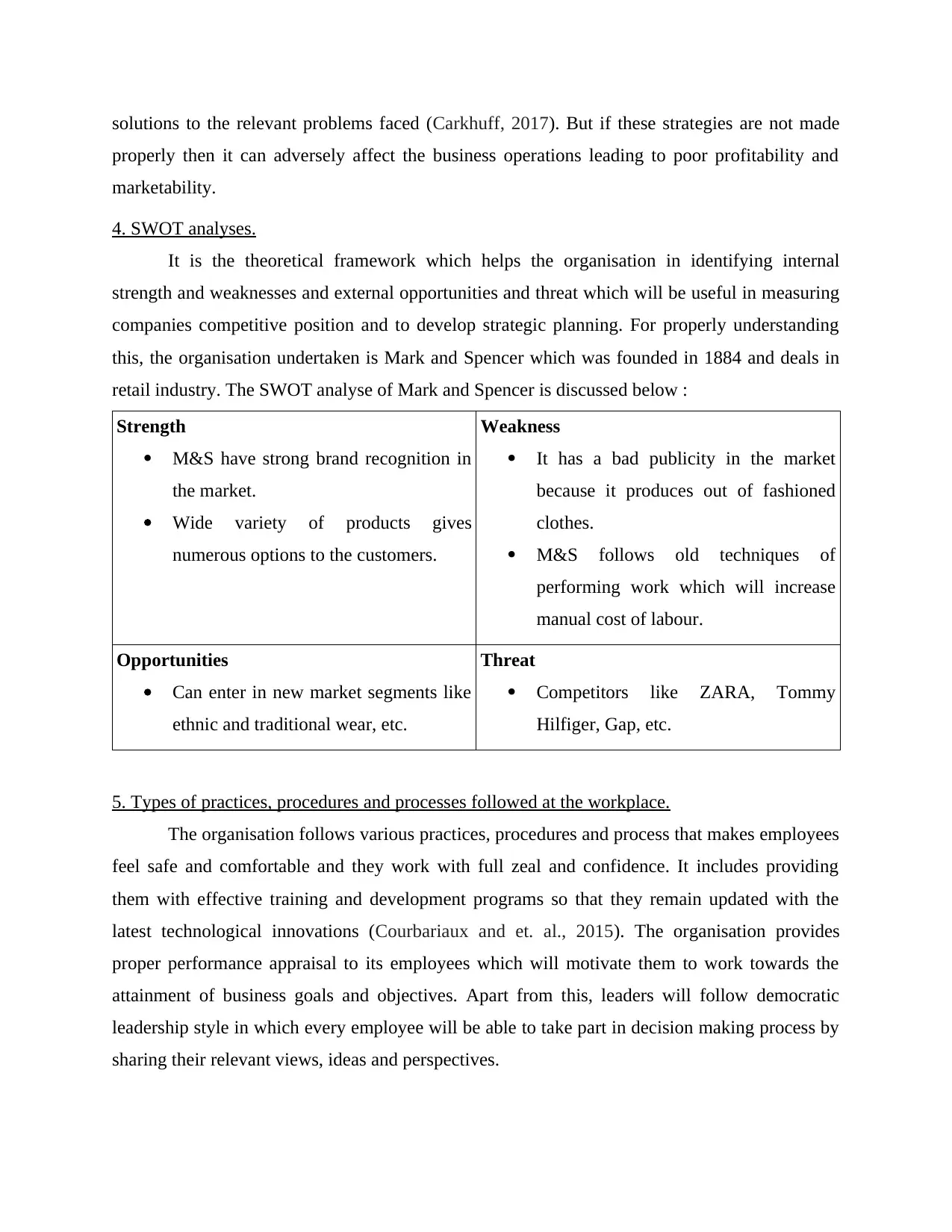
solutions to the relevant problems faced (Carkhuff, 2017). But if these strategies are not made
properly then it can adversely affect the business operations leading to poor profitability and
marketability.
4. SWOT analyses.
It is the theoretical framework which helps the organisation in identifying internal
strength and weaknesses and external opportunities and threat which will be useful in measuring
companies competitive position and to develop strategic planning. For properly understanding
this, the organisation undertaken is Mark and Spencer which was founded in 1884 and deals in
retail industry. The SWOT analyse of Mark and Spencer is discussed below :
Strength
M&S have strong brand recognition in
the market.
Wide variety of products gives
numerous options to the customers.
Weakness
It has a bad publicity in the market
because it produces out of fashioned
clothes.
M&S follows old techniques of
performing work which will increase
manual cost of labour.
Opportunities
Can enter in new market segments like
ethnic and traditional wear, etc.
Threat
Competitors like ZARA, Tommy
Hilfiger, Gap, etc.
5. Types of practices, procedures and processes followed at the workplace.
The organisation follows various practices, procedures and process that makes employees
feel safe and comfortable and they work with full zeal and confidence. It includes providing
them with effective training and development programs so that they remain updated with the
latest technological innovations (Courbariaux and et. al., 2015). The organisation provides
proper performance appraisal to its employees which will motivate them to work towards the
attainment of business goals and objectives. Apart from this, leaders will follow democratic
leadership style in which every employee will be able to take part in decision making process by
sharing their relevant views, ideas and perspectives.
properly then it can adversely affect the business operations leading to poor profitability and
marketability.
4. SWOT analyses.
It is the theoretical framework which helps the organisation in identifying internal
strength and weaknesses and external opportunities and threat which will be useful in measuring
companies competitive position and to develop strategic planning. For properly understanding
this, the organisation undertaken is Mark and Spencer which was founded in 1884 and deals in
retail industry. The SWOT analyse of Mark and Spencer is discussed below :
Strength
M&S have strong brand recognition in
the market.
Wide variety of products gives
numerous options to the customers.
Weakness
It has a bad publicity in the market
because it produces out of fashioned
clothes.
M&S follows old techniques of
performing work which will increase
manual cost of labour.
Opportunities
Can enter in new market segments like
ethnic and traditional wear, etc.
Threat
Competitors like ZARA, Tommy
Hilfiger, Gap, etc.
5. Types of practices, procedures and processes followed at the workplace.
The organisation follows various practices, procedures and process that makes employees
feel safe and comfortable and they work with full zeal and confidence. It includes providing
them with effective training and development programs so that they remain updated with the
latest technological innovations (Courbariaux and et. al., 2015). The organisation provides
proper performance appraisal to its employees which will motivate them to work towards the
attainment of business goals and objectives. Apart from this, leaders will follow democratic
leadership style in which every employee will be able to take part in decision making process by
sharing their relevant views, ideas and perspectives.
⊘ This is a preview!⊘
Do you want full access?
Subscribe today to unlock all pages.

Trusted by 1+ million students worldwide
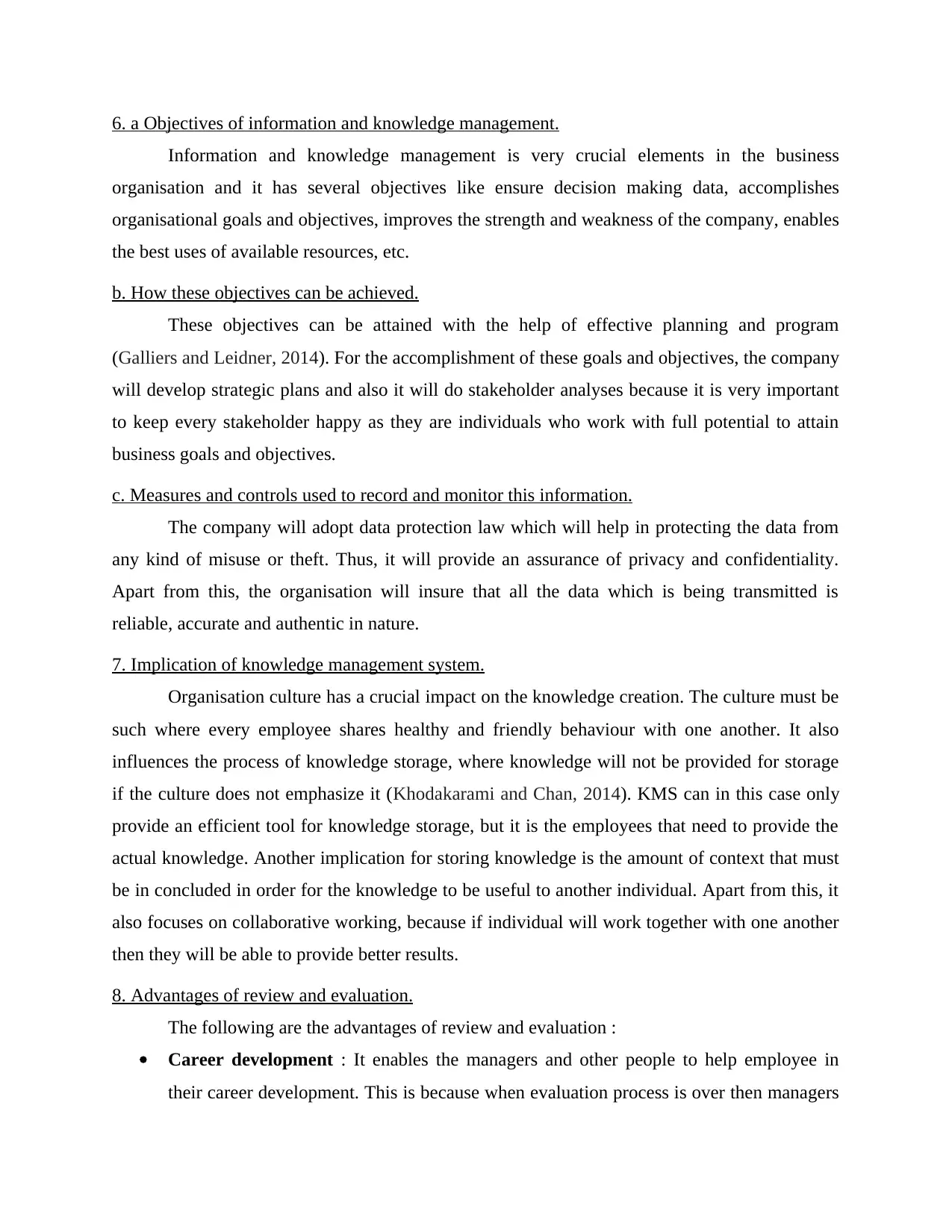
6. a Objectives of information and knowledge management.
Information and knowledge management is very crucial elements in the business
organisation and it has several objectives like ensure decision making data, accomplishes
organisational goals and objectives, improves the strength and weakness of the company, enables
the best uses of available resources, etc.
b. How these objectives can be achieved.
These objectives can be attained with the help of effective planning and program
(Galliers and Leidner, 2014). For the accomplishment of these goals and objectives, the company
will develop strategic plans and also it will do stakeholder analyses because it is very important
to keep every stakeholder happy as they are individuals who work with full potential to attain
business goals and objectives.
c. Measures and controls used to record and monitor this information.
The company will adopt data protection law which will help in protecting the data from
any kind of misuse or theft. Thus, it will provide an assurance of privacy and confidentiality.
Apart from this, the organisation will insure that all the data which is being transmitted is
reliable, accurate and authentic in nature.
7. Implication of knowledge management system.
Organisation culture has a crucial impact on the knowledge creation. The culture must be
such where every employee shares healthy and friendly behaviour with one another. It also
influences the process of knowledge storage, where knowledge will not be provided for storage
if the culture does not emphasize it (Khodakarami and Chan, 2014). KMS can in this case only
provide an efficient tool for knowledge storage, but it is the employees that need to provide the
actual knowledge. Another implication for storing knowledge is the amount of context that must
be in concluded in order for the knowledge to be useful to another individual. Apart from this, it
also focuses on collaborative working, because if individual will work together with one another
then they will be able to provide better results.
8. Advantages of review and evaluation.
The following are the advantages of review and evaluation :
Career development : It enables the managers and other people to help employee in
their career development. This is because when evaluation process is over then managers
Information and knowledge management is very crucial elements in the business
organisation and it has several objectives like ensure decision making data, accomplishes
organisational goals and objectives, improves the strength and weakness of the company, enables
the best uses of available resources, etc.
b. How these objectives can be achieved.
These objectives can be attained with the help of effective planning and program
(Galliers and Leidner, 2014). For the accomplishment of these goals and objectives, the company
will develop strategic plans and also it will do stakeholder analyses because it is very important
to keep every stakeholder happy as they are individuals who work with full potential to attain
business goals and objectives.
c. Measures and controls used to record and monitor this information.
The company will adopt data protection law which will help in protecting the data from
any kind of misuse or theft. Thus, it will provide an assurance of privacy and confidentiality.
Apart from this, the organisation will insure that all the data which is being transmitted is
reliable, accurate and authentic in nature.
7. Implication of knowledge management system.
Organisation culture has a crucial impact on the knowledge creation. The culture must be
such where every employee shares healthy and friendly behaviour with one another. It also
influences the process of knowledge storage, where knowledge will not be provided for storage
if the culture does not emphasize it (Khodakarami and Chan, 2014). KMS can in this case only
provide an efficient tool for knowledge storage, but it is the employees that need to provide the
actual knowledge. Another implication for storing knowledge is the amount of context that must
be in concluded in order for the knowledge to be useful to another individual. Apart from this, it
also focuses on collaborative working, because if individual will work together with one another
then they will be able to provide better results.
8. Advantages of review and evaluation.
The following are the advantages of review and evaluation :
Career development : It enables the managers and other people to help employee in
their career development. This is because when evaluation process is over then managers
Paraphrase This Document
Need a fresh take? Get an instant paraphrase of this document with our AI Paraphraser
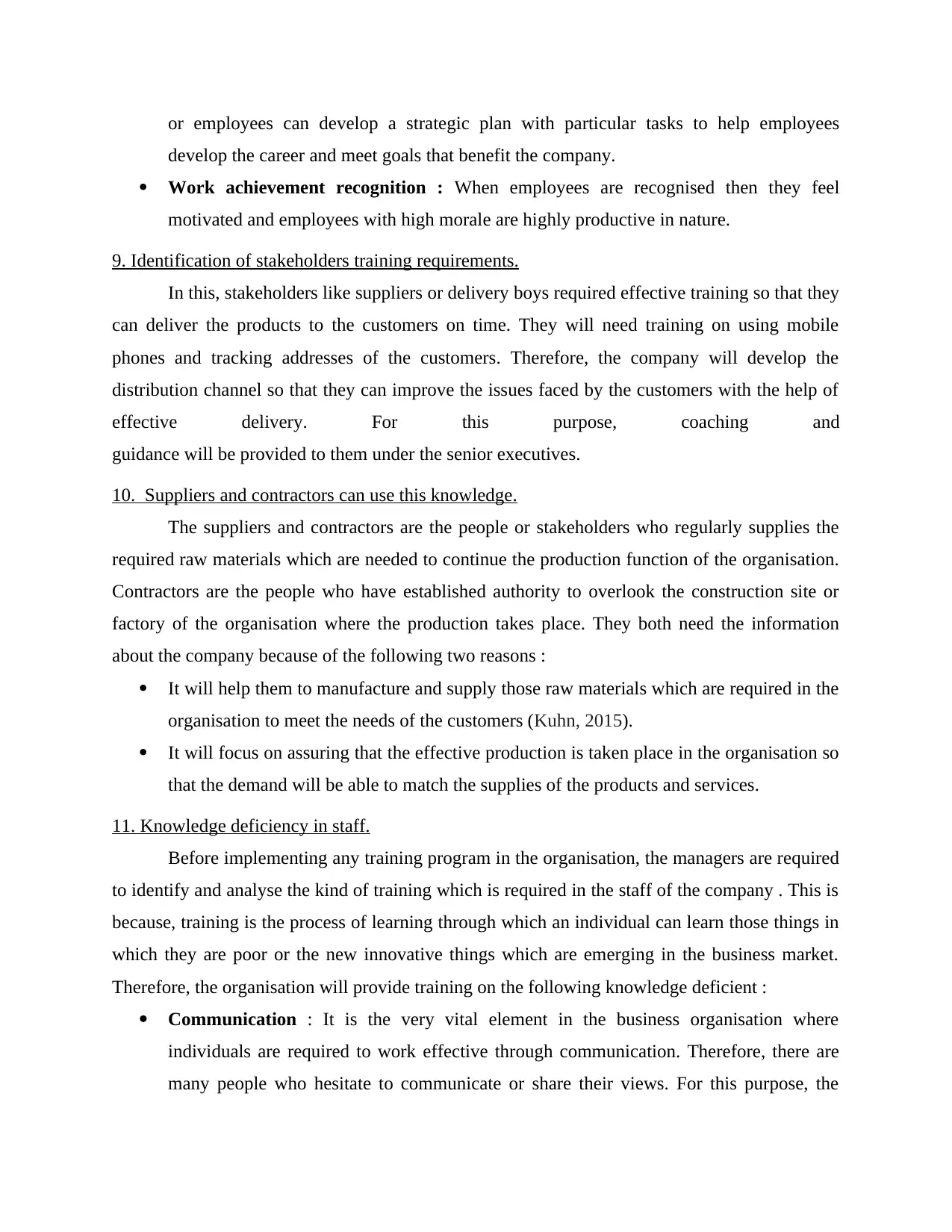
or employees can develop a strategic plan with particular tasks to help employees
develop the career and meet goals that benefit the company.
Work achievement recognition : When employees are recognised then they feel
motivated and employees with high morale are highly productive in nature.
9. Identification of stakeholders training requirements.
In this, stakeholders like suppliers or delivery boys required effective training so that they
can deliver the products to the customers on time. They will need training on using mobile
phones and tracking addresses of the customers. Therefore, the company will develop the
distribution channel so that they can improve the issues faced by the customers with the help of
effective delivery. For this purpose, coaching and
guidance will be provided to them under the senior executives.
10. Suppliers and contractors can use this knowledge.
The suppliers and contractors are the people or stakeholders who regularly supplies the
required raw materials which are needed to continue the production function of the organisation.
Contractors are the people who have established authority to overlook the construction site or
factory of the organisation where the production takes place. They both need the information
about the company because of the following two reasons :
It will help them to manufacture and supply those raw materials which are required in the
organisation to meet the needs of the customers (Kuhn, 2015).
It will focus on assuring that the effective production is taken place in the organisation so
that the demand will be able to match the supplies of the products and services.
11. Knowledge deficiency in staff.
Before implementing any training program in the organisation, the managers are required
to identify and analyse the kind of training which is required in the staff of the company . This is
because, training is the process of learning through which an individual can learn those things in
which they are poor or the new innovative things which are emerging in the business market.
Therefore, the organisation will provide training on the following knowledge deficient :
Communication : It is the very vital element in the business organisation where
individuals are required to work effective through communication. Therefore, there are
many people who hesitate to communicate or share their views. For this purpose, the
develop the career and meet goals that benefit the company.
Work achievement recognition : When employees are recognised then they feel
motivated and employees with high morale are highly productive in nature.
9. Identification of stakeholders training requirements.
In this, stakeholders like suppliers or delivery boys required effective training so that they
can deliver the products to the customers on time. They will need training on using mobile
phones and tracking addresses of the customers. Therefore, the company will develop the
distribution channel so that they can improve the issues faced by the customers with the help of
effective delivery. For this purpose, coaching and
guidance will be provided to them under the senior executives.
10. Suppliers and contractors can use this knowledge.
The suppliers and contractors are the people or stakeholders who regularly supplies the
required raw materials which are needed to continue the production function of the organisation.
Contractors are the people who have established authority to overlook the construction site or
factory of the organisation where the production takes place. They both need the information
about the company because of the following two reasons :
It will help them to manufacture and supply those raw materials which are required in the
organisation to meet the needs of the customers (Kuhn, 2015).
It will focus on assuring that the effective production is taken place in the organisation so
that the demand will be able to match the supplies of the products and services.
11. Knowledge deficiency in staff.
Before implementing any training program in the organisation, the managers are required
to identify and analyse the kind of training which is required in the staff of the company . This is
because, training is the process of learning through which an individual can learn those things in
which they are poor or the new innovative things which are emerging in the business market.
Therefore, the organisation will provide training on the following knowledge deficient :
Communication : It is the very vital element in the business organisation where
individuals are required to work effective through communication. Therefore, there are
many people who hesitate to communicate or share their views. For this purpose, the
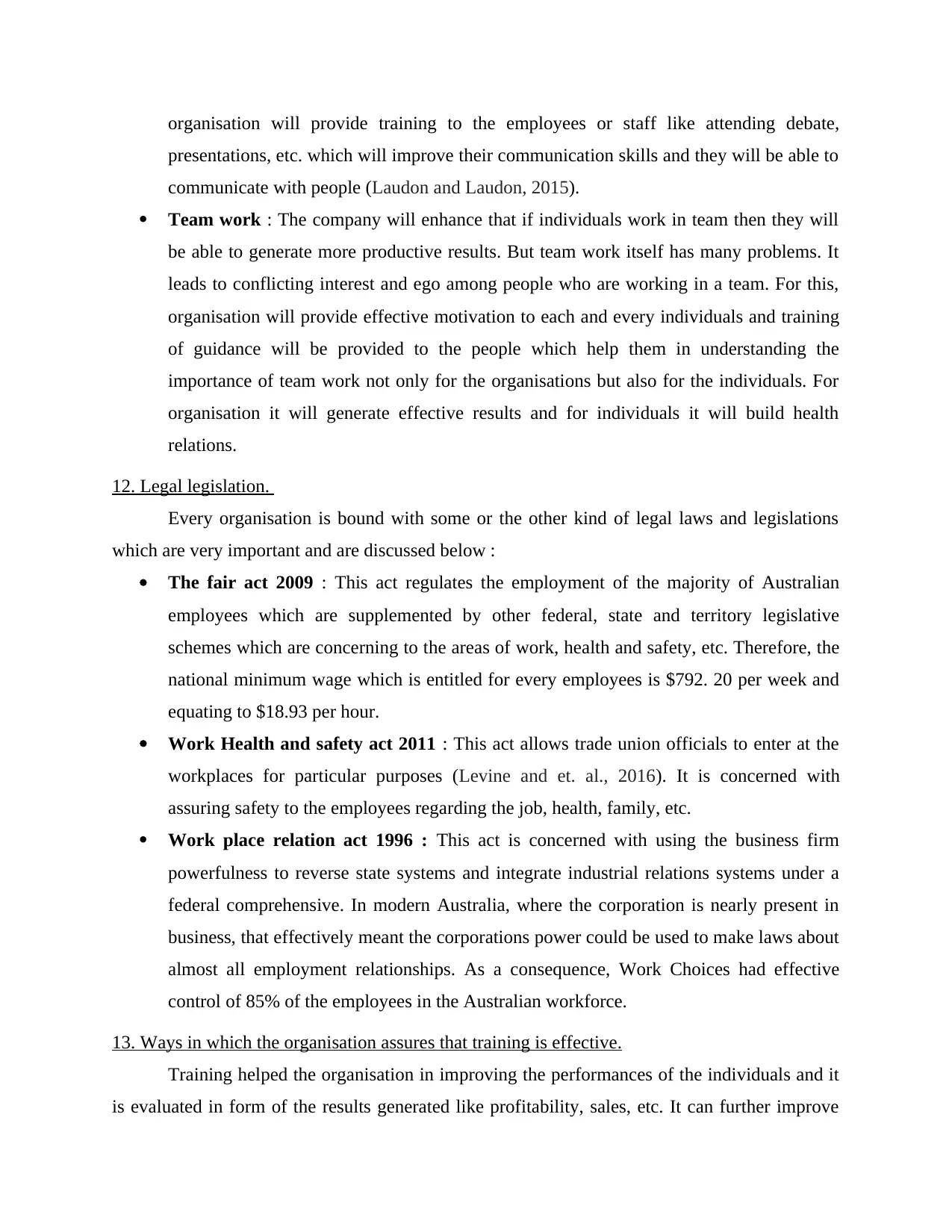
organisation will provide training to the employees or staff like attending debate,
presentations, etc. which will improve their communication skills and they will be able to
communicate with people (Laudon and Laudon, 2015).
Team work : The company will enhance that if individuals work in team then they will
be able to generate more productive results. But team work itself has many problems. It
leads to conflicting interest and ego among people who are working in a team. For this,
organisation will provide effective motivation to each and every individuals and training
of guidance will be provided to the people which help them in understanding the
importance of team work not only for the organisations but also for the individuals. For
organisation it will generate effective results and for individuals it will build health
relations.
12. Legal legislation.
Every organisation is bound with some or the other kind of legal laws and legislations
which are very important and are discussed below :
The fair act 2009 : This act regulates the employment of the majority of Australian
employees which are supplemented by other federal, state and territory legislative
schemes which are concerning to the areas of work, health and safety, etc. Therefore, the
national minimum wage which is entitled for every employees is $792. 20 per week and
equating to $18.93 per hour.
Work Health and safety act 2011 : This act allows trade union officials to enter at the
workplaces for particular purposes (Levine and et. al., 2016). It is concerned with
assuring safety to the employees regarding the job, health, family, etc.
Work place relation act 1996 : This act is concerned with using the business firm
powerfulness to reverse state systems and integrate industrial relations systems under a
federal comprehensive. In modern Australia, where the corporation is nearly present in
business, that effectively meant the corporations power could be used to make laws about
almost all employment relationships. As a consequence, Work Choices had effective
control of 85% of the employees in the Australian workforce.
13. Ways in which the organisation assures that training is effective.
Training helped the organisation in improving the performances of the individuals and it
is evaluated in form of the results generated like profitability, sales, etc. It can further improve
presentations, etc. which will improve their communication skills and they will be able to
communicate with people (Laudon and Laudon, 2015).
Team work : The company will enhance that if individuals work in team then they will
be able to generate more productive results. But team work itself has many problems. It
leads to conflicting interest and ego among people who are working in a team. For this,
organisation will provide effective motivation to each and every individuals and training
of guidance will be provided to the people which help them in understanding the
importance of team work not only for the organisations but also for the individuals. For
organisation it will generate effective results and for individuals it will build health
relations.
12. Legal legislation.
Every organisation is bound with some or the other kind of legal laws and legislations
which are very important and are discussed below :
The fair act 2009 : This act regulates the employment of the majority of Australian
employees which are supplemented by other federal, state and territory legislative
schemes which are concerning to the areas of work, health and safety, etc. Therefore, the
national minimum wage which is entitled for every employees is $792. 20 per week and
equating to $18.93 per hour.
Work Health and safety act 2011 : This act allows trade union officials to enter at the
workplaces for particular purposes (Levine and et. al., 2016). It is concerned with
assuring safety to the employees regarding the job, health, family, etc.
Work place relation act 1996 : This act is concerned with using the business firm
powerfulness to reverse state systems and integrate industrial relations systems under a
federal comprehensive. In modern Australia, where the corporation is nearly present in
business, that effectively meant the corporations power could be used to make laws about
almost all employment relationships. As a consequence, Work Choices had effective
control of 85% of the employees in the Australian workforce.
13. Ways in which the organisation assures that training is effective.
Training helped the organisation in improving the performances of the individuals and it
is evaluated in form of the results generated like profitability, sales, etc. It can further improve
⊘ This is a preview!⊘
Do you want full access?
Subscribe today to unlock all pages.

Trusted by 1+ million students worldwide
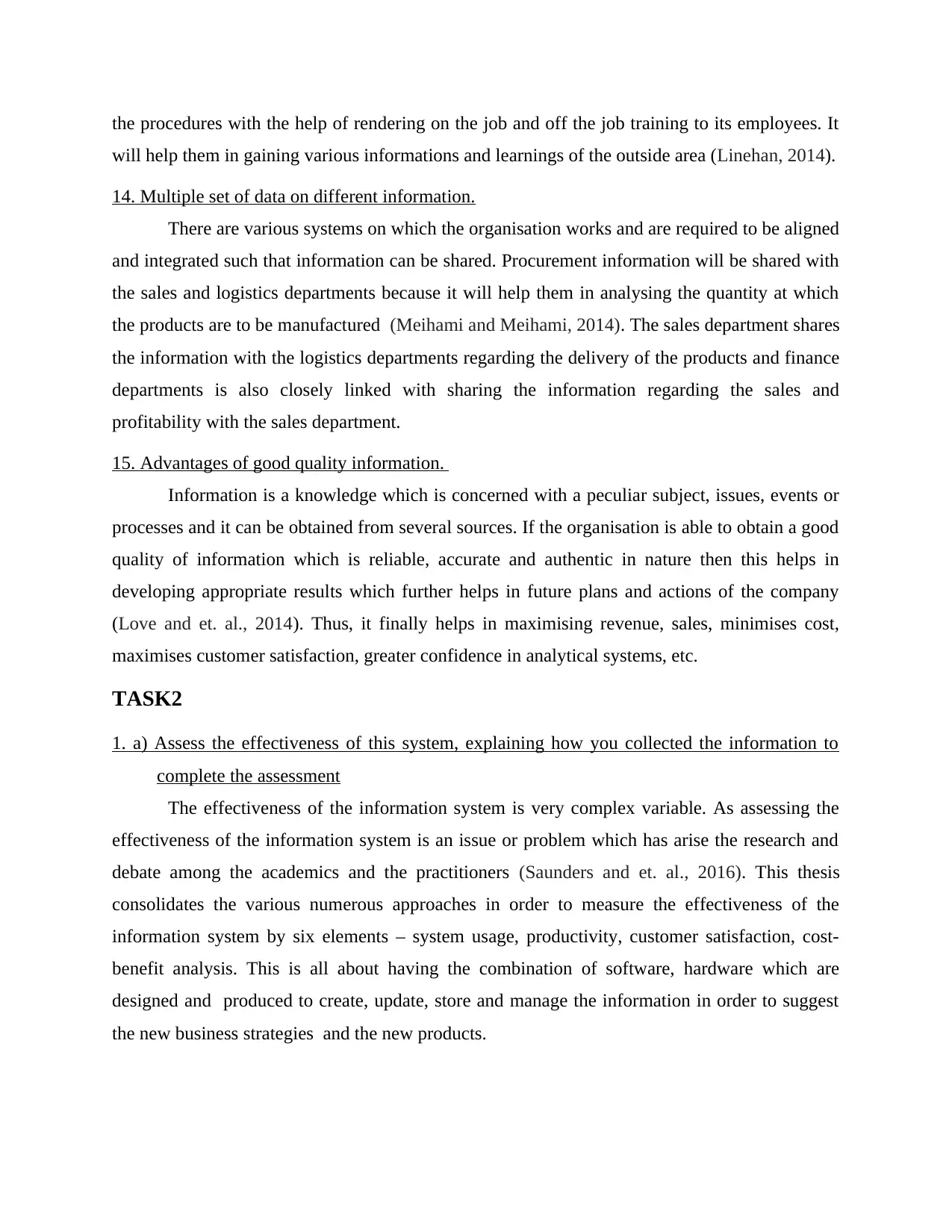
the procedures with the help of rendering on the job and off the job training to its employees. It
will help them in gaining various informations and learnings of the outside area (Linehan, 2014).
14. Multiple set of data on different information.
There are various systems on which the organisation works and are required to be aligned
and integrated such that information can be shared. Procurement information will be shared with
the sales and logistics departments because it will help them in analysing the quantity at which
the products are to be manufactured (Meihami and Meihami, 2014). The sales department shares
the information with the logistics departments regarding the delivery of the products and finance
departments is also closely linked with sharing the information regarding the sales and
profitability with the sales department.
15. Advantages of good quality information.
Information is a knowledge which is concerned with a peculiar subject, issues, events or
processes and it can be obtained from several sources. If the organisation is able to obtain a good
quality of information which is reliable, accurate and authentic in nature then this helps in
developing appropriate results which further helps in future plans and actions of the company
(Love and et. al., 2014). Thus, it finally helps in maximising revenue, sales, minimises cost,
maximises customer satisfaction, greater confidence in analytical systems, etc.
TASK2
1. a) Assess the effectiveness of this system, explaining how you collected the information to
complete the assessment
The effectiveness of the information system is very complex variable. As assessing the
effectiveness of the information system is an issue or problem which has arise the research and
debate among the academics and the practitioners (Saunders and et. al., 2016). This thesis
consolidates the various numerous approaches in order to measure the effectiveness of the
information system by six elements – system usage, productivity, customer satisfaction, cost-
benefit analysis. This is all about having the combination of software, hardware which are
designed and produced to create, update, store and manage the information in order to suggest
the new business strategies and the new products.
will help them in gaining various informations and learnings of the outside area (Linehan, 2014).
14. Multiple set of data on different information.
There are various systems on which the organisation works and are required to be aligned
and integrated such that information can be shared. Procurement information will be shared with
the sales and logistics departments because it will help them in analysing the quantity at which
the products are to be manufactured (Meihami and Meihami, 2014). The sales department shares
the information with the logistics departments regarding the delivery of the products and finance
departments is also closely linked with sharing the information regarding the sales and
profitability with the sales department.
15. Advantages of good quality information.
Information is a knowledge which is concerned with a peculiar subject, issues, events or
processes and it can be obtained from several sources. If the organisation is able to obtain a good
quality of information which is reliable, accurate and authentic in nature then this helps in
developing appropriate results which further helps in future plans and actions of the company
(Love and et. al., 2014). Thus, it finally helps in maximising revenue, sales, minimises cost,
maximises customer satisfaction, greater confidence in analytical systems, etc.
TASK2
1. a) Assess the effectiveness of this system, explaining how you collected the information to
complete the assessment
The effectiveness of the information system is very complex variable. As assessing the
effectiveness of the information system is an issue or problem which has arise the research and
debate among the academics and the practitioners (Saunders and et. al., 2016). This thesis
consolidates the various numerous approaches in order to measure the effectiveness of the
information system by six elements – system usage, productivity, customer satisfaction, cost-
benefit analysis. This is all about having the combination of software, hardware which are
designed and produced to create, update, store and manage the information in order to suggest
the new business strategies and the new products.
Paraphrase This Document
Need a fresh take? Get an instant paraphrase of this document with our AI Paraphraser
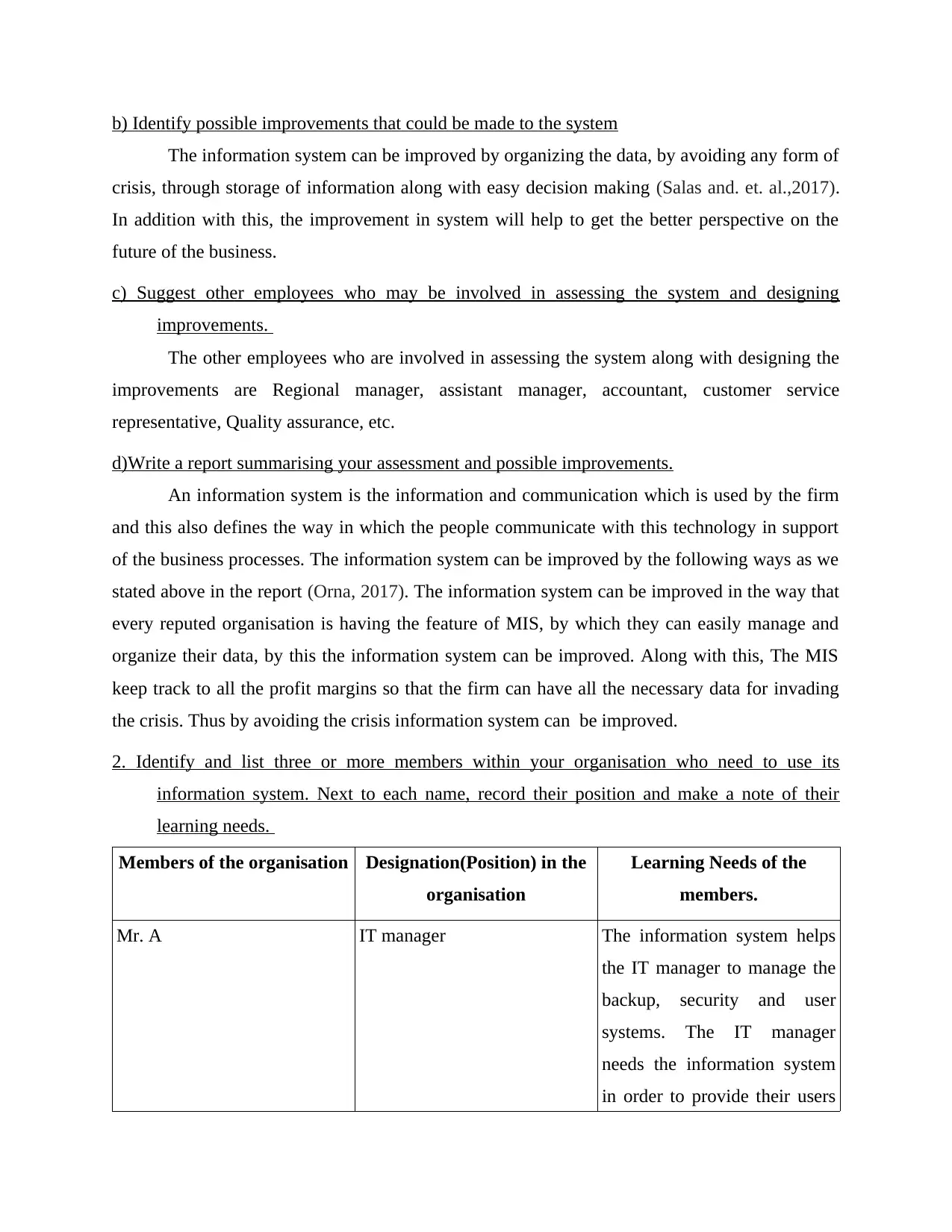
b) Identify possible improvements that could be made to the system
The information system can be improved by organizing the data, by avoiding any form of
crisis, through storage of information along with easy decision making (Salas and. et. al.,2017).
In addition with this, the improvement in system will help to get the better perspective on the
future of the business.
c) Suggest other employees who may be involved in assessing the system and designing
improvements.
The other employees who are involved in assessing the system along with designing the
improvements are Regional manager, assistant manager, accountant, customer service
representative, Quality assurance, etc.
d)Write a report summarising your assessment and possible improvements.
An information system is the information and communication which is used by the firm
and this also defines the way in which the people communicate with this technology in support
of the business processes. The information system can be improved by the following ways as we
stated above in the report (Orna, 2017). The information system can be improved in the way that
every reputed organisation is having the feature of MIS, by which they can easily manage and
organize their data, by this the information system can be improved. Along with this, The MIS
keep track to all the profit margins so that the firm can have all the necessary data for invading
the crisis. Thus by avoiding the crisis information system can be improved.
2. Identify and list three or more members within your organisation who need to use its
information system. Next to each name, record their position and make a note of their
learning needs.
Members of the organisation Designation(Position) in the
organisation
Learning Needs of the
members.
Mr. A IT manager The information system helps
the IT manager to manage the
backup, security and user
systems. The IT manager
needs the information system
in order to provide their users
The information system can be improved by organizing the data, by avoiding any form of
crisis, through storage of information along with easy decision making (Salas and. et. al.,2017).
In addition with this, the improvement in system will help to get the better perspective on the
future of the business.
c) Suggest other employees who may be involved in assessing the system and designing
improvements.
The other employees who are involved in assessing the system along with designing the
improvements are Regional manager, assistant manager, accountant, customer service
representative, Quality assurance, etc.
d)Write a report summarising your assessment and possible improvements.
An information system is the information and communication which is used by the firm
and this also defines the way in which the people communicate with this technology in support
of the business processes. The information system can be improved by the following ways as we
stated above in the report (Orna, 2017). The information system can be improved in the way that
every reputed organisation is having the feature of MIS, by which they can easily manage and
organize their data, by this the information system can be improved. Along with this, The MIS
keep track to all the profit margins so that the firm can have all the necessary data for invading
the crisis. Thus by avoiding the crisis information system can be improved.
2. Identify and list three or more members within your organisation who need to use its
information system. Next to each name, record their position and make a note of their
learning needs.
Members of the organisation Designation(Position) in the
organisation
Learning Needs of the
members.
Mr. A IT manager The information system helps
the IT manager to manage the
backup, security and user
systems. The IT manager
needs the information system
in order to provide their users
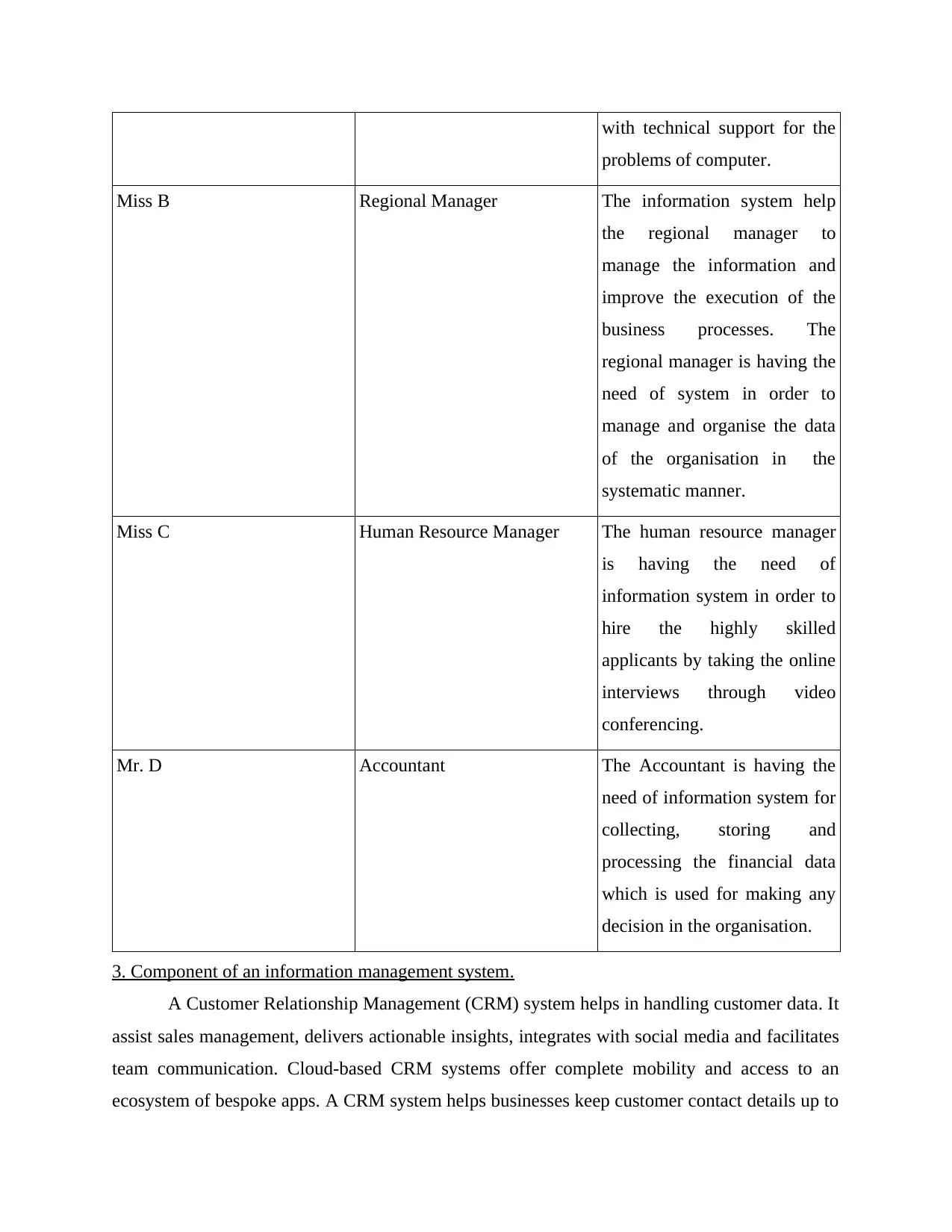
with technical support for the
problems of computer.
Miss B Regional Manager The information system help
the regional manager to
manage the information and
improve the execution of the
business processes. The
regional manager is having the
need of system in order to
manage and organise the data
of the organisation in the
systematic manner.
Miss C Human Resource Manager The human resource manager
is having the need of
information system in order to
hire the highly skilled
applicants by taking the online
interviews through video
conferencing.
Mr. D Accountant The Accountant is having the
need of information system for
collecting, storing and
processing the financial data
which is used for making any
decision in the organisation.
3. Component of an information management system.
A Customer Relationship Management (CRM) system helps in handling customer data. It
assist sales management, delivers actionable insights, integrates with social media and facilitates
team communication. Cloud-based CRM systems offer complete mobility and access to an
ecosystem of bespoke apps. A CRM system helps businesses keep customer contact details up to
problems of computer.
Miss B Regional Manager The information system help
the regional manager to
manage the information and
improve the execution of the
business processes. The
regional manager is having the
need of system in order to
manage and organise the data
of the organisation in the
systematic manner.
Miss C Human Resource Manager The human resource manager
is having the need of
information system in order to
hire the highly skilled
applicants by taking the online
interviews through video
conferencing.
Mr. D Accountant The Accountant is having the
need of information system for
collecting, storing and
processing the financial data
which is used for making any
decision in the organisation.
3. Component of an information management system.
A Customer Relationship Management (CRM) system helps in handling customer data. It
assist sales management, delivers actionable insights, integrates with social media and facilitates
team communication. Cloud-based CRM systems offer complete mobility and access to an
ecosystem of bespoke apps. A CRM system helps businesses keep customer contact details up to
⊘ This is a preview!⊘
Do you want full access?
Subscribe today to unlock all pages.

Trusted by 1+ million students worldwide
1 out of 15
Related Documents
Your All-in-One AI-Powered Toolkit for Academic Success.
+13062052269
info@desklib.com
Available 24*7 on WhatsApp / Email
![[object Object]](/_next/static/media/star-bottom.7253800d.svg)
Unlock your academic potential
Copyright © 2020–2025 A2Z Services. All Rights Reserved. Developed and managed by ZUCOL.





